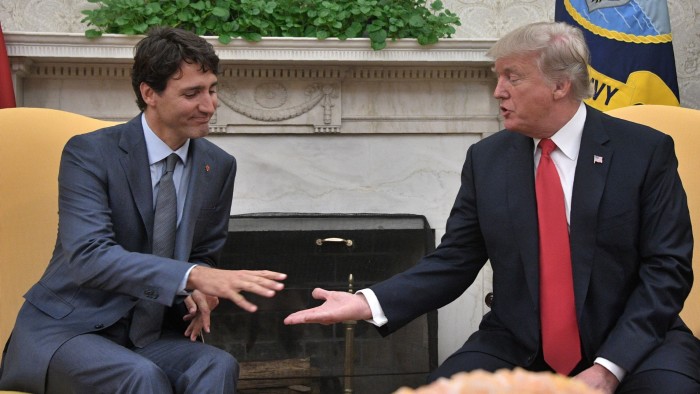Tariff Man’s superpowers are weaker than he thinks

Unlock the White House Watch newsletter for free
Your guide to what the 2024 US election means for Washington and the world
To you or me, Donald Trump’s self-bestowed epithet “Tariff Man” might sound like a tragically lame superhero that the creatives at Marvel Comics phoned in after a heavy night’s drinking, but for him it epitomises the global projection of American virility.
For Trump, import taxes are the philosopher’s stone that turns base metal into gold. They coerce trading partners into toeing US lines, close deficits (bilateral and overall) by keeping out cheap dumped imports, raise revenue, create jobs, revive manufacturing and generally make America great again, all in one go. Yesterday, he announced he would reappoint fellow tariff obsessive Peter Navarro, who served in his first administration, to a senior trade role in the White House.
Even before taking office Trump has threatened them twice: against Mexico and Canada if they don’t sort out immigration and the fentanyl trade, and against the Brics middle-income countries for their (almost non-existent) campaign for a currency to replace the US dollar.
Tariffs can certainly create good political optics. Following Trump’s threat, Canadian Prime Minister Justin Trudeau was on a plane to Florida and grinning dutifully at jokes about Canada becoming the 51st US state before you could say “auto industry”.
But in reality, even leaving aside that tariffs only affect goods rather than services, the US is a smaller player than its self-image seems to suggest. If Trump really does favour tariffs over other measures like export controls on technology and financial sanctions he will find them a clumsy and often ineffective way of asserting American power.
Quite simply, the US just isn’t that big in global trade any more. With a diverse production profile, it has always been quite a self-sufficient economy, and the rise of the Asian consumer pushed the US share of worldwide goods imports down to just 15.9 per cent last year, less than Europe (taking the EU and UK together) and only 3 percentage points above China.

The popular mental image of globalisation may be container ships laden with electronics crossing the Pacific from Shanghai to Los Angeles, but Simon Evenett, a professor at IMD Business School in Switzerland who founded the Global Trade Alert research initiative, says that US-China goods trade is only about 5 per cent of the global total. These days trade often involves shorter-haul regional journeys within south-east Asia.
With the exception of a few economies highly integrated with the US such as Mexico and Canada, most of those likely to face US tariff coercion could replace it as a final market with pain but without catastrophe. Evenett calculates that even if the US market were completely closed to a particular trading partner, by 2030 more than 100 of them, including Australia, China, Brazil, Saudi Arabia, India and Germany, would have recovered their lost exports elsewhere.

Countries may decide to give way to Trump’s demands rather than hurt politically sensitive sectors such as the car sector in Germany. But the evidence suggests that if they hold their nerve, they can ride out the worst of the shock.
The world trade system showed extraordinary flexibility and resilience after Trump imposed tariffs on Chinese goods during his first term. Quite apart from the loopholes negotiated by US companies such as Apple, production and distribution networks proved good at slinking around blocks on exports.
The US trade deficit with China, which Trump accuses of dumping cheap goods into the American market, did shrink after his tariffs were imposed. However, the overall US trade deficit increased and its imports from what the IMF calls “connector countries” like Vietnam and Mexico rose. Trump may go after those countries with tariffs too, but in that case, imports will either find a way round or get choked off altogether, causing a massive inflationary shock and/or recession to force domestic production and consumption into line.
The US is practised at using financial sanctions and to a lesser extent export controls on technology to restrain and coerce other countries — I’ll get to those in future columns — but it isn’t really set up to micromanage its trading partners’ behaviour with tariffs. And of course, the more Trump tries to repatriate production the less reliable the US will be as an import market and the more the rest of the world will trade without it. The US is already removing itself from the global market for electric vehicles with prohibitive 100 per cent tariffs on Chinese EVs.
Beijing itself knows the limits to blocking other countries’ exports, having tried and failed to coerce Australia and Lithuania into changing political stances by restricting trade. Indeed, China has been relatively restrained about retaliating against US tariffs during the Trump and Biden administrations, perhaps realising the damage to its own economy from an escalating trade war. This week Beijing announced export bans on some critical minerals including germanium and gallium in retaliation for US controls on semiconductor technology, but such restrictions weren’t exactly crippling when China tried them on the EU in the past.
If Tariff Man goes into action against Dumper, his Chinese arch-enemy, his victory is very far from assured. Tariffs may have an intuitive appeal, but the evidence suggests they are a weaker superpower than Trump supposes.
#Tariff #Mans #superpowers #weaker #thinks




